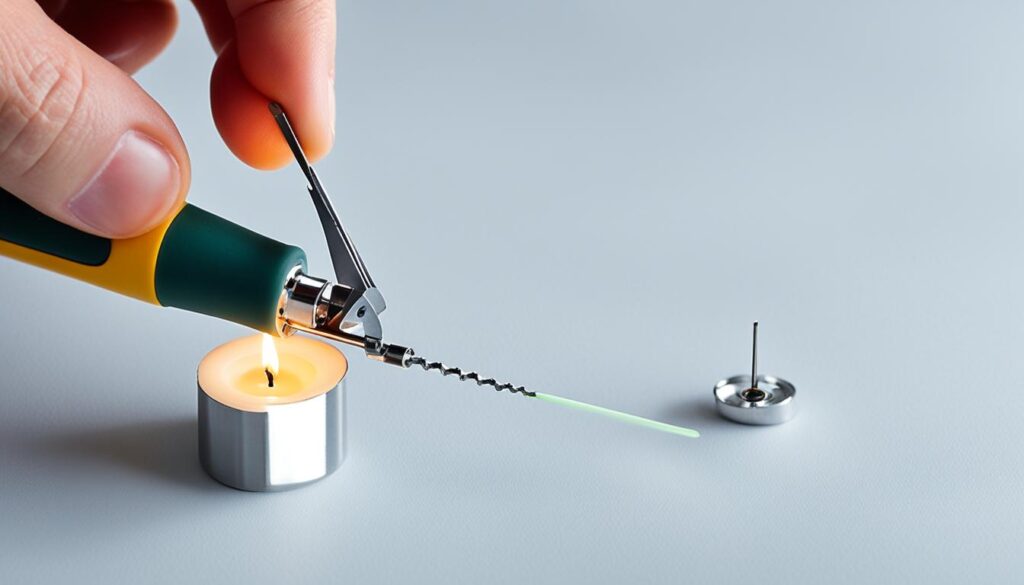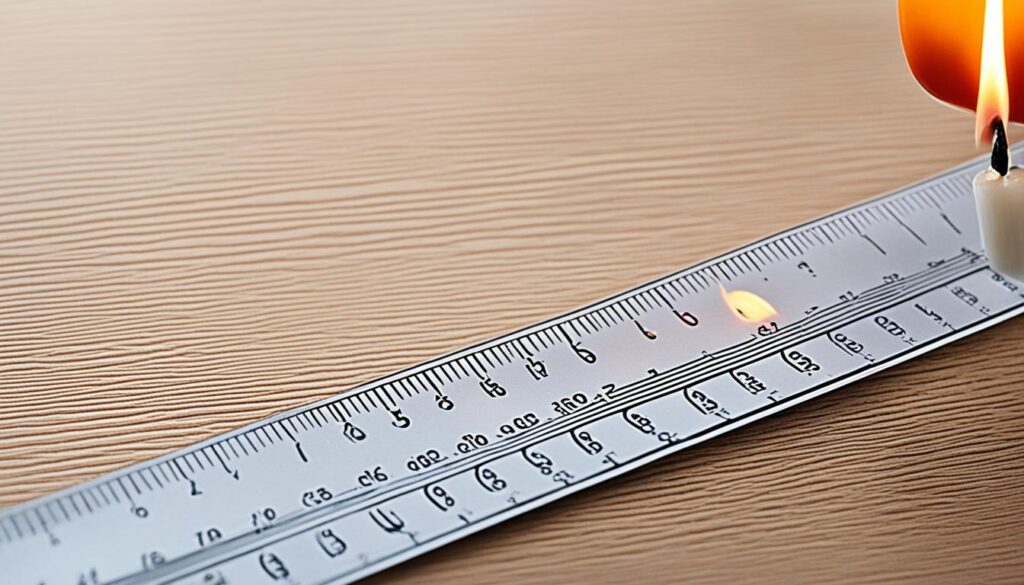Beginner Candle Making Tips: Avoid Common Mistakes
Are you a budding candle maker wanting to dodge beginner blunders? This guide is for you! It uncovers the main errors newbies make and how to dodge them for beautiful, professional candles every time. Learn the secrets of perfect candle pouring, wick placement, and proper curing. These tips will make your candles the star of the show!
Key Takeaways
- Preheat containers to 40°C before pouring wax for a flawless finish
- Use wick centering tools to ensure wicks are straight and centered
- Trim wicks to 10mm before lighting for optimal burn performance
- Fill candles to the right amount to avoid issues with height
- Always test candles before distributing to ensure safety and quality
Pre-heating Containers for Paraffin Wax
Many new candle makers make a big mistake. They pour paraffin wax into cold containers. This can really affect how your candles look, especially if you’re using clear glass jars.
Putting hot paraffin wax into cold containers can cause “jump lines.” These are lines or ridges that appear as the wax cools and contracts. It happens because the temperature isn’t even.
The Importance of Preheating
To prevent this, you should preheat your candle containers before adding wax. Heat them to about 40°C (104°F). This makes sure the wax cools and contracts evenly, giving you a smooth finish.
Preheating is key when using paraffin wax. It has a high melting point. So, preparing your materials well will lead to beautiful, quality candles that people will love.
“Attention to detail is the key to success in candle making. Preheating your containers is a simple step that can make a big difference in the final appearance of your candles.”
Candle making tips like preheating containers are crucial for great results, especially with paraffin wax tips. By preparing your materials, you’ll make stunning candle jar preheating candles that will impress everyone.
Centering Wicks Properly
Proper wick centering is key in candle making. It makes the candle look good and burn evenly. Many beginners put the wick off-center, leading to an uneven burn and a less professional look.
To keep your wicks in the middle, use wick centering tools. These tools keep the wick straight and in place as the wax cools. Candle wick centering and wick alignment are vital for a professional look.
It’s also important to keep the wick tight to stop it from moving off-center as the wax hardens. By focusing on proper wick placement, your candles will look polished and high-quality. This will impress your friends and customers.
“Proper wick centering is the foundation for creating beautiful, evenly burning candles.”
Details matter in candle making. Mastering candle wick centering leads to professional-grade candles that will impress everyone.
Trimming Wick Lengths
As a candle lover, you know the right wick length is key for great candle wick trimming, consistent wick length, and wick performance. Wrong wick lengths can cause problems like too much soot, uneven burning, and safety risks.
It’s important to trim wicks the same way every time. Most candles should have a wick about 10 millimeters (mm) long before lighting. This size ensures a steady, clean flame that burns well.
- Use sharp, high-quality wick trimmers for a clean cut.
- Trim the wicks to 10mm before lighting each time, even if they look short.
- Don’t let the wick get too long, as it can cause a big flame, more soot, and safety issues.
Keeping wicks at a consistent length makes candle burning better and safer. You’ll get a more enjoyable experience with great wick performance.
| Wick Length | Impact on Candle Performance |
|---|---|
| 10mm | Optimal flame size, clean burn, consistent wick performance |
| Less than 10mm | Smaller flame, uneven burning, reduced wick performance |
| Greater than 10mm | Larger flame, increased soot production, potential safety issues |
“Consistent wick trimming is the key to ensuring a safe, enjoyable, and visually appealing candle-burning experience.”
Follow these easy tips and keep wicks the same length to improve your candle-making. You’ll make a product that looks and smells great, making your home more welcoming.
Using Wick Trimming Tools
Keeping your candle wicks at the same length is key for even burning. A simple wick trimmer tool makes this easy. By trimming your wicks regularly, you get a steady flame. This stops sooting and flickering.
Mistake 4: Inconsistent Wick Lengths
Not trimming your wicks can cause problems. Uneven lengths make the flame act strangely, leading to an uneven burn. This looks bad and can be unsafe. With a good candle wick trimmer, you can keep your wicks even for better candle wick maintenance.
Trimming your wicks is easy with a wick trimmer. Just hold it at a 90-degree angle and clip the wick. This keeps your candles burning well and looking great.
“Proper wick trimming is the secret to a long-lasting, even-burning candle. It’s a small step that can make a big difference in your finished product.”
Being consistent with candle wick maintenance is important. Use a quality candle wick trimmer and trim your wicks often. This ensures your candles burn well every time.

Proper Candle Filling Amounts
Filling your candle just right is key for both looks and performance. If you put too much or too little wax, you could face problems like uneven burning or unstable candles. It’s vital to get the candle fill amount, candle container sizing, and candle wax quantity right.
Mistake 5: Unusual Candle Heights
Beginners often make the mistake of using the wrong amount of wax. Too little wax makes the candle burn too fast. Too much wax can spill over, making a mess. Aim for about 220g of fragranced wax for a 30cl candle jar or container.
Measuring and filling your candles carefully helps prevent unusual candle heights. This ensures a steady, long burn. The candle fill amount impacts how your candles look and work.
Learning how to fill candles properly is crucial. Mastering this skill leads to making candles that are both beautiful and enjoyable to use.
Testing Candles for Safety and Performance
It’s key to make sure your handmade candles are safe and of good quality. Before you share them, you must test them thoroughly. This step is crucial to avoid any dangers and to make sure your customers are happy.
Guidelines like EN 15493:2019 and EN 15426:2018 give clear rules for checking candle safety and how long they last. Following these candle performance standards helps your products meet the industry’s best levels. This ensures your customers always have a great experience.
Mistake 6: Skipping Testing
Not testing your candles can be a big mistake for new candle makers. Without testing, you might sell candles that:
- Could be a fire hazard because of bad wicks or wrong wax amounts
- Make too much smoke or soot, which is bad for the air inside
- Burn unevenly, giving customers a bad experience
Putting in the effort to test your candles well protects your brand’s good name. It shows you care about candle safety and quality. This small step gives you and your customers peace of mind.
“Candle safety is paramount, and testing is the foundation for ensuring your products meet the highest standards.”
Allowing Proper Cure Times
Curing your candles is a key step often missed by new candle makers. The candle curing process means letting your candles sit still for 48 hours or more. This time lets the wax harden fully and the fragrance develop fully. This makes the candle burn evenly and last longer.
Being impatient can ruin the candle curing. If you light a candle too soon, it can burn unevenly or even be dangerous. The wax might not be set right, causing problems like tunneling or wax overflowing.
Mistake 7: Insufficient Curing Times
New candle makers often don’t wait long enough for their candles to cure. Skipping this step can really hurt the quality and safety of your candles. Here’s why curing times matter:
- Ensures the wax fully hardens and sets for a clean, even burn
- Allows the fragrance to fully develop and release
- Reduces the risk of issues like wax overflow or wick problems
- Results in a longer-lasting, more consistent burning candle
To avoid this mistake, always follow the wax and wick maker’s curing time advice. Experts usually say to cure candles for at least 48 hours before lighting them. Waiting for your candles to cure fully will make them work better and give you a nicer candle experience.
“Patience is the key to great candles. Don’t rush the curing process – your candles (and your nose) will thank you.”
Checking Flame Height
The flame height of a candle is very important. It makes your candle look great and keeps it safe. Let’s look at why checking and adjusting the flame size is key for homemade candles.
The ideal flame height for a 30cl jar or container is between 20-30mm. This size gives a warm, cozy feel without being too big or too small. It’s important to check and adjust the flame size often for candle safety and performance.
Flame Size Testing
To make sure your candle flame is just right, follow these steps:
- Light the candle and let it burn for at least 30 minutes, so the wax melts fully.
- Measure the flame’s height from the wax surface using a ruler or measuring tape.
- If the flame is over 30mm, trim the wick with a wick trimmer to get it back in range.
- Keep testing and adjusting until you get the perfect candle flame height.
Checking and adjusting the flame size often helps make candles that look great and are safe for everyone.
| Candle Size | Ideal Flame Height |
|---|---|
| 30cl Jar or Container | 20-30mm |

“Achieving the ideal candle flame height is essential for creating a safe and enjoyable candle-burning experience.”
It’s easy to make sure your homemade candles are both pretty and safe. Just take the time to check the flame height and adjust as needed. This way, you can enjoy your candles without any surprises.
Aftersmoke Considerations
As a candle lover, you know the candle aftersmoke or afterglow matters a lot. It should last no more than 15 seconds for safety and satisfaction. Not paying attention to candle smoke management can cause problems.
Many candle makers forget about the aftersmoke’s impact. Candle Shack’s expert guide shows why it’s key to manage this for a great candle experience.
To get a clean, controlled aftersmoke and afterglow, follow these tips:
- Pick wax and wick types that reduce aftersmoke.
- Try different wax mixes and additives to lessen aftersmoke.
- Keep an eye on the flame height and adjust it for a clean burn.
- Teach your customers how to take care of their candles to manage aftersmoke and afterglow.
Focus on the candle aftersmoke and afterglow for a better candle experience. Details matter in making safe, enjoyable candles.
beginner candle making tips
Starting your candle making journey means learning about different waxes and their techniques. Before you begin, make sure to research wax-specific tips. This ensures your candles will look great. You’ll learn about cold and hot throw scents and how to place the wick just right.
Be patient and open to learning as you go. Candle making is an art that takes time to master. Try out different waxes, scents, and wick sizes to see what suits your candles best. Remember, everyone’s candles are unique, but being flexible and informed will lead you to success.
If you’re new or want to improve, keep an eye on beginner candle making tips, candle making best practices, and starting candle making. This will help you make the most of this fun hobby. Enjoy the process, learn from it, and let your creativity show in every candle.
FAQ
How can I avoid “jump lines” on my candles when pouring paraffin wax?
How can I ensure my candles have a professional appearance?
What’s the best way to maintain proper wick lengths?
How much wax should I use for a 30cl candle jar or container?
What safety and performance standards should I test my candles against?
How long should I cure my candles before lighting?
What’s the ideal flame height for a 30cl candle jar or container?
How long should the aftersmoke or afterglow last for optimal safety and customer experience?
Do different waxes require different pouring and finishing techniques?
Source Links
- https://armatagecandlecompany.com/blog/6-mistakes-new-candle-makers-should-avoid/ – 6 Mistakes New Candle Makers Should Avoid | Candle Making
- https://candle-shack.co.uk/blogs/all-blogs/common-mistakes-in-candle-making-and-how-to-avoid-them – Common Mistakes In Candle Making And How To Avoid Them
- https://www.craftovator.co.uk/blogs/academy/5-things-every-beginner-candle-maker-gets-wrong – 5 Common Mistakes Beginner Candle Makers Make
- Fragrance That Wows: A Beginner’s Guide to Adding Scents to Your Homemade Candles
- best essential oils for candles
- wood wick guide
- how to make candles smell stronger
- how to ship candles
- how to fix soy wax frosting
- wick Guide how to choose the right wick size with chart
- how to make candle molds
- how to clean candle wax
- how to reuse candle jars
- soy wax candle troubleshooting
- best wax melter for candle making
- how to conduct burn test
- why candle flickering crackling smoking
- how much wax per candle
- how to make candles smell stronger
- Easy Ways to Increase the Scent Throw of Your DIY Candles
- How to Make Candles for Meditation and Relaxation
- Using Upcycled Materials in Candle Making
- How to Make Hand-Poured Candles: Tips and Techniques

Leave a Reply